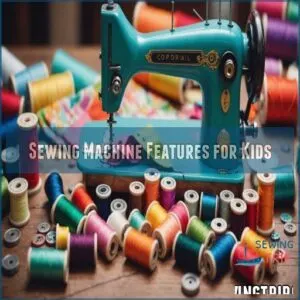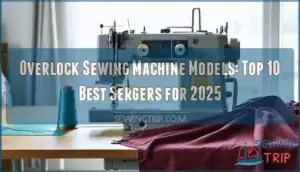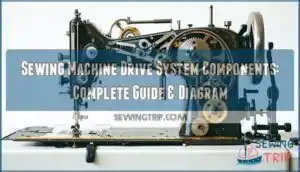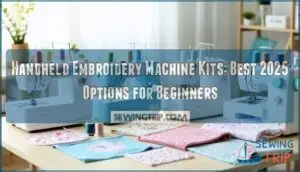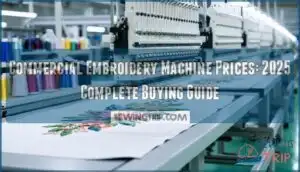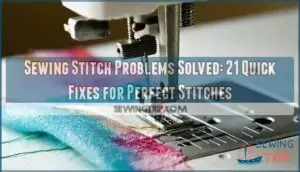This site is supported by our readers. We may earn a commission, at no cost to you, if you purchase through links.
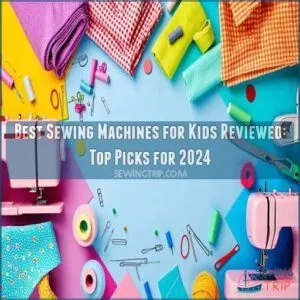 Choosing the best sewing machines for kids reviewed involves a bit of a treasure hunt.
Choosing the best sewing machines for kids reviewed involves a bit of a treasure hunt.
Picture colorful models like the Janome Fastlane, perfect for young beginners with simple controls—ideal if you’ve ever watched a little one try to thread a needle!
Safety features such as needle guards and speed control keep creativity flowing without the chaos.
Look for machines offering built-in stitches and automatic threading.
Durability is key, so opt for sturdy frames and check those reviews for real-world insights.
Curious about which machine sews a perfect storm of features and fun? Stay tuned, and you’ll find out!
Table Of Contents
Key Takeaways
- Consider your child’s age and skill level to choose the right sewing machine, ensuring it matches their needs and promotes skill advancement.
- Prioritize safety features like needle guards and speed controls to protect little fingers and make sewing safer and more enjoyable.
- Look for essential machine features such as built-in stitches, automatic threading, adjustable speed control, and a free arm to enhance usability and versatility.
- Choose machines with a durable build and good customer support, ensuring longevity and providing peace of mind with reliable warranties.
Choosing The Best Sewing Machine for Kids
When choosing the best sewing machine for kids, consider their age and skill level, along with essential safety features like needle guards.
Look for kid-friendly models that have features such as adjustable speed controls, which can make learning both fun and secure.
Age and Skill Level Considerations
When selecting the best sewing machine for kids, it’s essential to consider key features like built-in stitches and variable speed control, as discussed in the guide to the best sewing machine for kids. Choosing the best sewing machine for kids? Start with age and skill level.
Young beginners might need simpler, colorful models like the Janome Fastlane.
For more options, check out the various top kids sewing machines that cater to different age groups and skill levels.
Look for age-appropriate stitches and consider skill progression.
As children advance, machines with more complexity foster growth.
Always factor in supervision needs, especially for those new to sewing.
Choose wisely for enjoyable beginners projects.
Safety Features to Look For
When looking for a sewing machine for your child, prioritize these safety features to keep little fingers safe:
- Needle Guards: These shields prevent accidental pricks.
- Foot Pedal Control: This feature lets them sew at their own pace.
- Speed Limits: Slower speeds reduce mishaps, letting creativity shine.
Remember, supervision is key to sewing success and safety!
Types of Sewing Machines for Kids
For kids just starting out, a machine with safety features like finger guards is essential. Toy sewing machines are perfect for sparking creativity in young ones, offering a playful start with easy-to-use controls.
When introducing kids to sewing, it’s essential to consider safety features, such as finger guards and finger protection, to ensure a safe and enjoyable experience. Beginner models introduce basics without overwhelming kids, while mini sewing machines provide compact solutions for space-limited areas.
Kids sewing kits often include a variety of beginner-friendly features like the ones found in the best handheld sewing machine for kids, such as portable sewing machines. Kids sewing kits often accompany these machines, providing affordable options for learning.
Remember, exploring sewing machine types sets the foundation for budding tailors’ joyful journey!
Benefits of Sewing Machines for Kids
Beyond the fun, sewing machines boost kids’ skills! You’ll unleash creativity, designing unique projects.
Fine motor skills improve with precise needlework.
Problem-solving blossoms as you troubleshoot.
Confidence soars with each completed creation, teaching patience and perseverance.
A sewing machine is a fantastic tool for teens, offering sewing machine education and inspiration. It’s more than a hobby; it’s empowerment!
Sewing Machine Features for Kids
When choosing a sewing machine for kids, you’ll want to focus on features like built-in stitches and buttonholes, speed control, and a free arm to make sure it’s versatile and easy to use.
Look for machines with automatic needle threading, adjustable thread tension, and an array of accessories to make sewing fun and frustration-free for young learners.
Built-in Stitches and Buttonholes
Choosing the right machine for kids involves checking built-in stitches and buttonholes. You’ll want a machine that offers variety and simplicity.
For a wide range of kids sewing machines with various stitch types, check out kids sewing machine options.
Here’s what to keep in mind:
- Stitch Types: From basic to decorative.
- Buttonhole Types: Automatic ones are a big plus.
- Instruction Clarity: Easy guides boost confidence.
- Suitable for All Ages: Even toddlers and teenagers will find it user-friendly.
Speed Control and Free Arm
After mastering stitches and buttonholes, you’ll appreciate the speed control benefits, such as precision and accuracy in stitching, and free arm uses.
A handy speed adjustment feature allows your little one to manage sewing machine speed confidently, enhancing safety, and this feature is especially beneficial when working with various fabric types and speed control.
With a free arm, sewing sleeves and cuffs becomes simpler, helping teach practical skills.
Plus, foot pedal control adds precision, making every stitch just right!
Included Feet and Accessories
Foot on the pedal, you’ve got speed sorted, but what about included feet and accessories? These are a game-changer.
Basic machines, like the Brother XM2701, often come with essential feet for zig-zag and buttonholes.
Extras like storage solutions keep chaos at bay.
Peek at common accessories too, ensuring your kid’s sewing machine is stocked like a chef’s kitchen.
Automatic Needle Threader and Tension
Let’s thread into needle threader benefits and tackle tension problems. Mastering these features saves time and avoids headaches.
- Needle Threader Benefits: No more squinting, just quick threading magic.
- Thread Tension Basics: Keep stitches even without frustration.
- Tension Adjustment: Fine-tune your sewing machine for smooth sewing.
Mastering a sewing machine is easier with the right tools and resources, such as checking out the top picks for best sewing machine for beginners. These tricks boost your sewing machine learning and overall sewing machine quality.
What Makes a Good Sewing Machine for Kids?
When you’re picking a sewing machine for kids, focus on ease of use and durability, so they can enjoy creating without getting frustrated.
A model that offers good value for money, along with reliable customer support and a solid warranty, gives you peace of mind for both you and your budding tailor.
Ease of Use and Setup
So, you’ve mastered the features; now, let’s talk ease of use!
Look for simple controls and intuitive threading—that’s key for beginners.
Quick setup is a must; nobody wants a complicated first project.
Beginner-friendly features, like automatic needle threading, are lifesavers.
Easy maintenance means less frustration and more sewing time.
A sewing machine with these features makes learning fun, not a chore!
Durability and Build Quality
In choosing a sewing machine for kids, durability and build quality are very important.
Opt for machines with a sturdy frame, preferably metal, to withstand enthusiastic use.
Plastic components might be lighter but often less durable.
Weigh the machine to make sure it’s well-balanced—too heavy, and it’s unwieldy; too light, and it might topple.
Make sure parts are readily available for easy repairs.
Price and Value for Money
After considering durability, you’ll want a sewing machine that balances cost with features—a needle in a haystack, right?
Checking out websites like Everysimply best sewing machines for kids can give you an idea of the various models available.
Aim for models offering budget-friendly options but check their stitch variety and ease.
Affordable doesn’t mean compromising on quality.
A good price-quality balance will help nurture sewing skills, turning dreams into stitched reality without breaking the bank.
Customer Support and Warranty
When you’re spending your hard-earned cash, you want peace of mind.
Look for sewing machines with solid customer support and warranties.
These little insurance policies can save big headaches if something goes wrong.
- Warranty length matters for your peace of mind.
- Reliable repair options are a lifesaver.
- Check customer reviews for real-world insights.
- A sewing machine community offers support and tips!
Frequently Asked Questions (FAQs)
How to choose the right sewing machine for your child?
Like finding the perfect pair of shoes, choosing a sewing machine for your child means considering their age and experience.
Look for safety features, like a needle guard, simple stitches, and automated options to make sure the experience is fun and safe.
Which sewing machine is best for kids?
You’ll want a machine that’s easy to use, safe, and durable. Consider the Singer Start 1304 or Janome Arctic Crystal for beginners. They’re simple, affordable, and perfect for learning the ropes!
What is the best sewing machine for beginners?
Ever wonder which sewing machine suits beginners best. The best option is often a kid-friendly design with safety features like finger guards, as seen in top kid’s sewing machines reviewed. Ever wonder which sewing machine suits beginners best?
The SINGER Simple 3232 stands out, offering an automatic needle threader, 32 built-in stitches, durability, and a heavy-duty metal frame, making sewing projects a breeze.
Are sewing machines kid-friendly?
Sewing machines can be kid-friendly if you pick the right one.
Look for models with safety features like needle guards, easy controls, and bright designs.
Supervise kids closely and make sure clear instructions are available.
What’s a good sewing machine for kids?
Consider the Brother XM2701 for kids.
It’s affordable, offers 27 stitches, and has an intuitive design.
Safety features include an automatic needle threader and a drop-in bobbin, making it both user-friendly and reliable for beginners.
Can a 7 year old use a sewing machine?
You might wonder, "Is a sewing machine safe for a 7-year-old?"
With supervision and proper instruction, they can safely start sewing.
Opt for models with speed control, safety features, and a straightforward design to ease learning.
What is the easiest sewing machine to learn on?
When starting sewing, the Singer Simple 3232 makes learning a breeze with its 32 stitches and automatic needle threader.
It’s almost like your own little assistant, ready to tackle projects with ease and style.
What is the most dependable sewing machine?
Picture a sewing needle dancing effortlessly through fabric; you’d want a dependable machine like the Brother XM2701.
It’s praised for its 27 built-in stitches, automatic features, and durability, ensuring your sewing projects flow smoothly and reliably.
How safe are toy sewing machines for kids?
Toy sewing machines, while fun, need adult supervision. They’re generally safe, but moving parts and needles require careful handling. Always teach kids safety first, before letting them use the machine.
Can kids easily fix sewing machine jams?
Kids might find fixing sewing machine jams tricky.
Encourage them with a gentle nudge to follow the manual’s guidance, slowly unfurl tangled threads, and make sure the bobbin’s correctly seated.
Patience and practice make perfect, just like tying shoelaces.
What age should children start advanced sewing projects?
At around ten to twelve years old, children can handle advanced sewing projects, mastering skills like complex patterns.
Encourage their curiosity, but make sure they understand safety, use proper tools, and embrace creativity as they grow.
Are there online tutorials for kids learning to sew?
Absolutely, you can find tons of online tutorials for kids learning to sew.
Websites like YouTube offer step-by-step videos, while platforms like Creativebug provide structured courses designed to make sewing accessible and fun for younger learners.
Do sewing machines come with kid-friendly sewing patterns?
Did you know the sewing machine market for kids is growing by 7% annually?
Many kid-friendly sewing machines include simple patterns, encouraging creativity.
These machines often come with basic project ideas to kickstart young imaginations.
Conclusion
Starting your sewing journey with kids is like threading a tapestry of creativity and skill.
The best sewing machines for kids reviewed here offer features designed to nurture young talent.
From easy threading to safety measures, these machines balance fun and functionality, ensuring happy learners.
Consider age, skill level, and budget, and choose a durable model.
With the right machine in hand, you’re set for rewarding sewing adventures, fostering creativity and confidence in your child.

